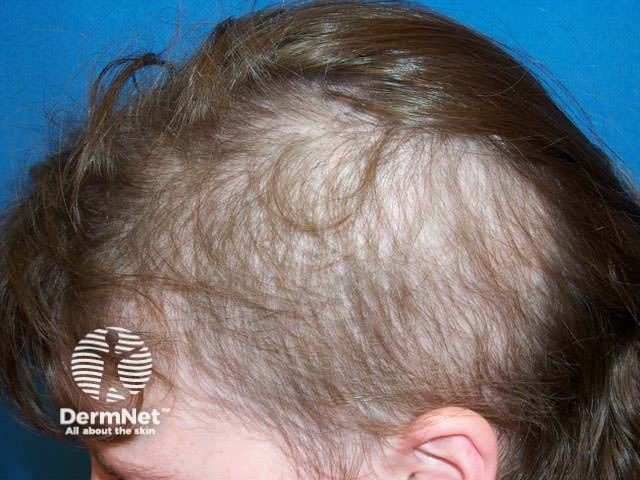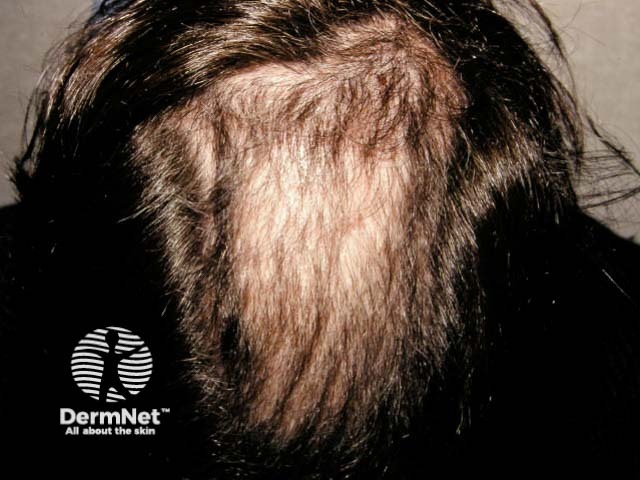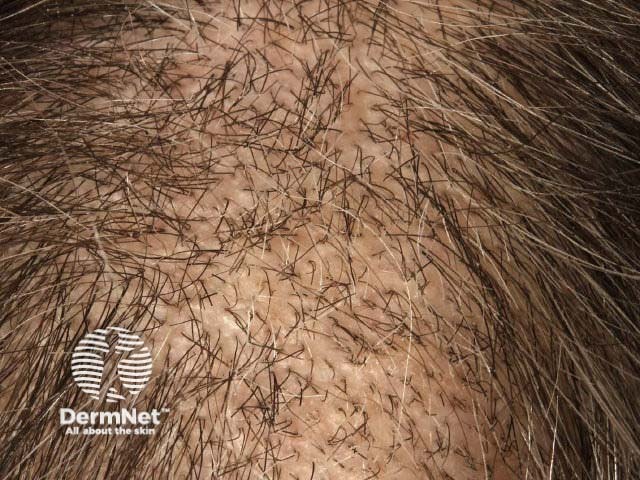Main menu
Common skin conditions

NEWS
Join DermNet PRO
Read more
Quick links
Trichotillomania — extra information
Trichotillomania
Author: Sharmaine Recabar, 5th Year Medical Student, University of Auckland, New Zealand; Chief Editor: Hon A Prof Amanda Oakley, Dermatologist, Hamilton, New Zealand, July 2016.
Introduction
Demographics
Causes
Clinical features
Complications
Diagnosis
Treatment
Outcome
What is trichotillomania?
Trichotillomania is a disorder characterised by an irresistible urge to remove or pull one's own hair, which results in alopecia (hair loss). Trichotillomania is also called trichotillosis or hair-pulling disorder.
Who gets trichotillomania?
Trichotillomania is estimated to affect up to 4% of the general population. It can affect males and females of any age but is more common in children than in adults. Peak of onset usually occurs in the pre-school years and also in early adolescence, usually around the time of puberty.
In children, trichotillomania affects boys and girls equally but with increasing age, it is seen more frequently in females. It is unclear whether this is because women are more likely to seek treatment. Males may also be able to disguise hair pulling as male pattern baldness and by shaving.
What causes trichotillomania?
The exact cause of trichotillomania still remains largely unknown. Note:
- There is a possible genetic tendency to trichotillomania.
- Trichotillomania often arises in individuals with obsessive-compulsive disorder.
- It may develop as a coping mechanism triggered by stress or anxiety.
- It is commonly associated with other body-focused repetitive behaviours, such as nail biting (onychophagia), nail picking (habit-tic nail deformity) skin picking, acne excorié, lip biting and cheek chewing.
- Neurological factors may be involved.
What are the clinical features of trichotillomania?
The most common site of hair pulling is the scalp. Hairs may also be pulled from the eyebrows, eyelashes, trunk, arms, legs and pubic area.
- Sites of hair pulling may change over time.
- Some people with trichotillomania extract hairs they perceive to be different in length and texture from other hairs.
- The hair puller may or may not be aware of the habit. It may occur when the individual is engaged in other activities such as watching television, reading, studying and talking on the phone. It may also occur deliberately associated with compulsive urges and anxiety that are alleviated by hair pulling. Many individuals display both types of hair-pulling behaviour.
- Hair pulling may be pleasurable and is not usually described as painful.
Hair loss patterns vary from mild thinning or unnoticeable areas of hair loss to completely bald areas.
- Examination of the scalp may reveal irregularly-shaped patches of alopecia.
- They may feel stubbly, with hairs of varying lengths.
- Children tend to pull on hairs that are easy to reach and are on the same side as their dominant hand. These are usually the frontotemporal areas (areas behind the forehead and ears) and the vertex (top of the head).
- Eyelashes and eyebrows may also be broken or absent.
- Scratches, bruises and erythema from picking may also be seen.
- Repeated removal of hair damages the follicles and may lead to irreversible scarring

Trichotillomania


See more images of trichotillomania ...
What are the complications of trichotillomania?
Trichobezoar (undigested hair balls) is a rare but potentially life-threatening complication of trichotillomania, which results from ingestion of pulled hair (trichophagia). It may present with abdominal pain, nausea, vomiting and constipation. It may also cause bowel obstruction or perforation.
Other reported complications include:
- Localised skin infections
- Blepharitis from extraction of eyelashes
- Chronic pain due to prolonged abnormal postures whilst hair pulling
- Carpal tunnel syndrome
How is trichotillomania diagnosed?
It is important to exclude other causes of hair loss, especially alopecia areata. A dermatological assessment may include:
- Hair pull test – negative
- Wood light to rule out fungal infection
-
Dermatoscopy and/or trichoscopy findings:
- Reduced hair density
- Broken hairs of uneven length
- Trichoptillosis (split/frayed ends)
- Hair powder
- Short vellus hairs
-
Biopsy and histology findings:
- Catagen hairs
- Dystrophic hairs
- Relatively non-inflammatory dermis
- Fractured hair shafts
- Plugging of dilated follicles with debris (keratin and melanin casts)
A psychiatric evaluation may also necessary but may be difficult in young children. Trichotillomania falls under the obsessive-compulsive and related disorders category, according to the American Psychiatric Association's Diagnostic and Statistical Manual of Mental Disorders, Fifth Edition (DSM-5).
What is the treatment for trichotillomania?
Treatment should start with reassurance, education of parent and caregiver, and discussion around possible options to manage the condition. Treatment usually involves some form of behavioural therapy including parental techniques. In younger children, management is usually conservative, attempting to prevent hair pulling (cutting hair close to the scalp, gloves or socks to cover the child's hands), gentle reminder when hair pulling is observed, and time-outs. Treatment of other behaviours such as thumb sucking may also be helpful.
In older children, other behavioural therapies may be possible. The techniques used vary widely and may include habit reversal training.
In resistant cases in adolescents and adults, medications such as tricyclic antidepressants (eg clomipramine) and selective serotonin uptake inhibitors may be considered. Limited evidence has suggested that N-acetylcysteine may help.
What is the outcome for trichotillomania?
In younger children, trichotillomania tends to be benign and self-limiting. Children usually outgrow the condition.
In adolescents and adults, trichotillomania may be episodic but tends to be chronic. It is associated with more psychopathology and may be more difficult to treat. Affected individuals may feel embarrassed, attempt to mask hair loss and consequently have issues with low self-esteem.
References
- Bruce TO, Barwick LW, Wright HH. Diagnosis and management of trichotillomania in children and adolescents. Paediatr Drugs. 2005;7(6):365–76. doi: 10.2165/00148581-200507060-00005. PMID: 16356024. PubMed
- Castelo-Soccio L. Diagnosis and management of alopecia in children. Pediatr Clin North Am. 2014 Apr;61(2):427–42. doi: 10.1016/j.pcl.2013.12.002. Epub 2014 Jan 21. PMID: 24636654. PubMed
- Duke DC, Keeley ML, Geffken GR, Storch EA. Trichotillomania: A current review. Clin Psychol Rev. 2010 Mar;30(2):181–93. doi: 10.1016/j.cpr.2009.10.008. Epub 2009 Oct 30. PMID: 19926375. PubMed
- Giuseppe H, Hercogova J, Torello L. Trichotillomania. J Am Acad Dermatol. 2002;46(6):807–26. Journal
- Parmar NV, Kuruvila S, Thilakan P. Early-onset trichotillomania: A case report with dermoscopic findings. Indian J Paediatr Dermatol 2016;17:65–7. PubMed
On DermNet
- Hair loss
- Disorders of hair and scalp
- Nail biting (onychophagia)
- Habit-tic nail deformity
- Trichophagia
- Treatment of psychodermatological disorders
- The mind and the skin
- Treatment of psychodermatological disorders
- Trichoscopy of localised noncicatricial hair loss
Other websites
- Trichotillomania — Medscape
- Trichotillomania — MedlinePlus
- Trichotillomania — KidsHealth
- Trichotillomania — NHS Choices
- Trichotillomania Support Online
- The TLC Foundation for body focused repetitive behaviours
- Infographic about trichotillomania and treatment options — Trichstop
